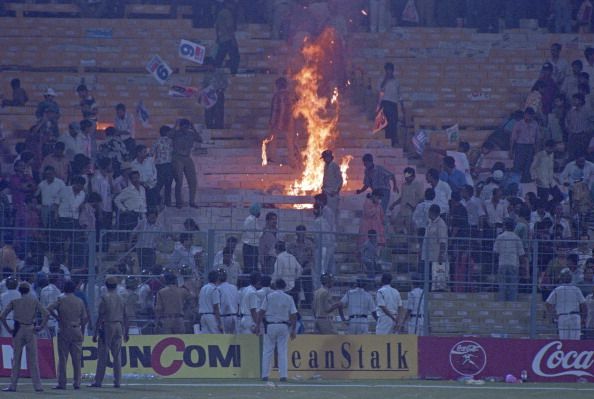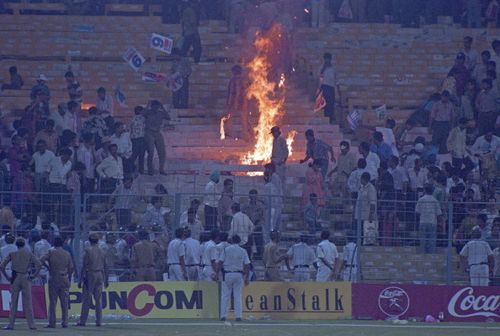
1996 Cricket World Cup Semifinals: Calcutta '96 - India's Maracanazo

Eden Gardens was up in flames
When I look back on my childhood, the 1996 cricket World Cup comes to mind instantly. Being less than six years old at the time, it was the first major sporting event that I was aware of. I can recollect nice memories but it all culminates in Vinod Kambli’s tears.
1996 was boom-time for cricket in India. Liberalization was in full swing. One of the advertisement boards on the boundary during the game said “Jockey – Now in India”. Pepsi and Coke were pumping money into the game, coloured clothing and the white ball were still a novelty. When the World Cup came around, the country was buzzing in anticipation.
In the previous meeting between the two sides in the group stage, India had set Sri Lanka a target of 272, a stiff ask in those days. Sri Lanka came out all guns blazing. The openers tore into the Indian attack. In those days, reaching 100 by the 25th over was a respectable achievement, which is what India had managed. Sri Lanka reached 50 in 5 and 100 in 15, a scoring rate that was unheard of.
The opening partnership of Jayasuriya and Kaluwitharana is credited with revolutionizing one-day batsmanship. They were pioneers in exploiting the field restrictions in the first fifteen overs. Using this start as a platform, Sri Lanka cruised to the target.
To get to the semifinal, India had seen off Pakistan in a memorable quarterfinal in Bangalore. Ajay Jadeja’s exhilarating knock of 45 off 25 to finish India’s innings, in which he hit Waqar to all corners of the park, was the highlight of the match I watched in Adilabad. But surely the most unforgettable memory from that glorious night was Venkatesh Prasad cleaning up Aamir Sohail. Following such a wonderful win, the nation expected the team to go all the way.
On to Calcutta then, for the semifinal. If Bal Gangadhar Tilak were around, he would’ve said it was our birthright to win that match. The Eden Gardens, packed with God alone knows how many people, was heaving with the uncontrollable passion of around one lakh people. Unlike now, back then very few stands had permanently fixed seats, a factor that restricts capacity in modern stadia to a controllable number. The stands in those days were mainly cement slabs and people would be packed in like hens in a poultry cage.
These three matches were the only ones I remember watching in that World Cup. Being five and a half years old, I’d just started watching cricket and did not yet have the maturity to be a “true lover of the game”. Hence the only team I cared about was India, and in the wake of the traumatic semifinal loss, I did not bother about the final between Australia and Sri Lanka.
The sea of humanity at the Eden Gardens created an atmosphere similar to the one created by the largest crowd ever to attend a football match – an estimated 200,000 people packed the Maracana to watch the 1950 FIFA World Cup ‘final’. Playing in front of such a crowd, the home team knows that defeat is not an option. I cannot begin to fathom the amount of pressure those Indian cricketers and Brazilian footballers must’ve been under.
I use quotes for ‘final’ because it wasn’t a conventional one-off contest to decide the winner. The format of that tournament was to have a final group stage of four teams, each playing one another with two points for a win and one for a draw. The team that topped the group would be world champion. Going into the final game of the tournament, only these two teams were in contention for the title. Uruguay needed to win; a draw would be enough for Brazil.
Brazil were so confident of victory that preparations for all sorts of celebrations were already in place. The evening before the game, the headline in São Paulo’s Gazeta Esportiva was: “Tomorrow we will beat Uruguay!” Rio’s O Mundo printed a shot of the players, saying: “These are the world champions.” Before the match began the selecao were given solid gold watches stating: ‘For the World Champions’. Millions of T-shirts proclaiming victory slogans had been printed. Even the FIFA president Jules Rimet – waiting to hand over his golden namesake – had written his victory speech in Portuguese, lauding the Brazilian winners.
Sri Lanka came in to bat first. Javagal Srinath, that tireless hero of India’s seam attack (I can’t use the word ‘fast’ to describe any of our mid-to-late 90s bowlers) gave India an unimaginably good start. Sri Lanka lost both their openers in the first four balls, each of them swinging at a wide one and slashing it straight down third man’s throat. 1/2 after 0.4 overs. Not in my wildest dreams.
Watching at home, I thought that was the match won right there. I started celebrating India’s entry into the World Cup final.
Having been indoctrinated into the Indian cricket fan’s mindset in which, if Sachin is out early, one might as well turn off the TV, I never even remotely considered the possibility of the middle order batsmen coming to Sri Lanka’s rescue. The two batsmen I feared the most were out, and as far as I was concerned, Sri Lanka were wasting everyone’s time by continuing with the match. Why wouldn’t they just win by “declaration”?
I only remember the first over from Sri Lanka’s innings. I’ve had to go back to Youtube to watch the rest of their innings. What a wonderful knock by Aravinda de Silva it was, especially those drives through cover against the quicker bowlers. The Calcutta crowd appreciated his mastery, giving him a good hand on reaching his fifty in 32 balls.